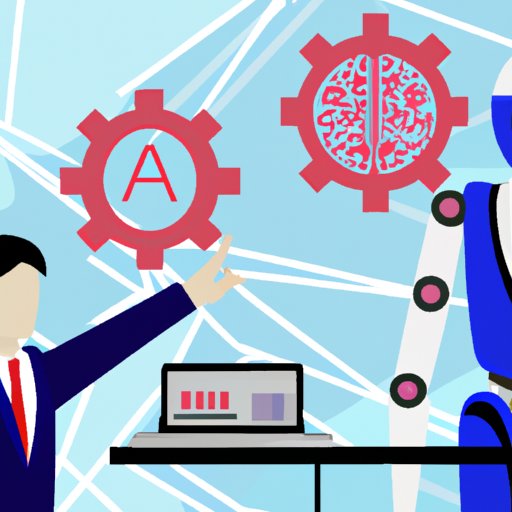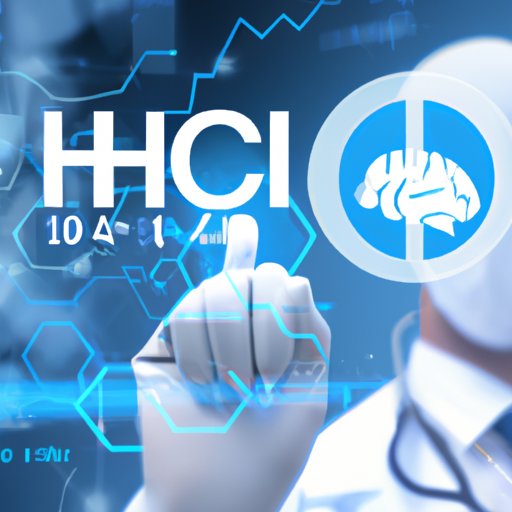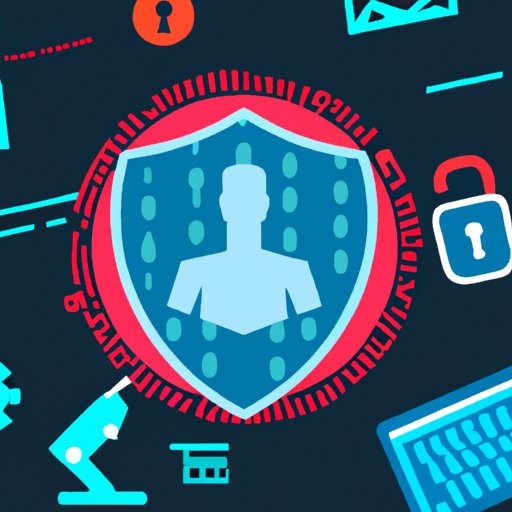Introduction
Artificial Intelligence (AI) is a rapidly developing field that has the potential to revolutionize our lives. AI technology has already begun to reshape industries and everyday life in ways we could have only dreamed of decades ago. From automated processes to intelligent cities, AI has the potential to revolutionize the way we live and work.
In this article, we will explore how AI can change the world in five key areas: smart cities, automation of menial tasks, healthcare, education, and cybersecurity. We will discuss the potential benefits, challenges, and provide examples of existing AI-driven initiatives.
Smart Cities: How AI Can Drive City Planning and Development
Smart cities are cities that use technology, data, and AI to improve urban planning, infrastructure, and services. By leveraging AI, smart cities can reduce traffic congestion, improve public safety, and optimize energy usage. AI can also be used to analyze data to identify patterns and trends in order to inform decisions related to city planning.
Potential Benefits of AI-Driven City Planning
The potential benefits of AI-driven city planning are numerous. AI can help cities identify problems and develop solutions faster than ever before. AI can also help cities become more efficient by automating mundane tasks and freeing up human resources to focus on higher-level tasks. Additionally, AI can help cities save money by optimizing energy usage and reducing waste.
Examples of AI-Powered City Planning
One example of an AI-powered city is Songdo, South Korea. Songdo is a planned city that leverages AI for everything from traffic management to energy efficiency. The city uses AI to monitor and manage traffic flow, optimize energy usage, and detect anomalies in the city’s infrastructure. Additionally, Songdo has implemented AI-driven facial recognition technology to improve public safety.
Challenges Facing AI-Driven City Planning
As with any new technology, there are some challenges facing AI-driven city planning. One challenge is ensuring that data is collected ethically and used responsibly. Additionally, AI systems can be difficult to maintain and update, which can lead to costly repairs and downtime. Finally, AI-driven solutions can be expensive to implement, which can limit their adoption in lower-income areas.

Automation of Menial Tasks: How AI Can Increase Efficiency in the Workplace
Automation is the process of using technology to automate mundane or repetitive tasks. Automation has the potential to drastically increase efficiency in the workplace, freeing up human resources to focus on higher-level tasks. AI-driven automation can also help reduce costs and eliminate errors.
Benefits of Automating Menial Tasks
The benefits of automating menial tasks are numerous. Automation can reduce costs by eliminating the need for manual labor. Additionally, automation can increase efficiency by eliminating the possibility of human error. Automation can also free up human resources to focus on more complex tasks, allowing companies to get more done in less time.
Examples of Automated Processes
One example of an automated process is robotic process automation (RPA). RPA is a type of software that automates mundane tasks such as data entry and document processing. Companies can use RPA to streamline processes and reduce costs. Additionally, RPA can help ensure accuracy by eliminating the possibility of human error.
Challenges Facing Automated Processes
As with any new technology, there are some challenges facing automated processes. One challenge is ensuring that data is collected ethically and used responsibly. Additionally, automated processes can be difficult to maintain and update, which can lead to costly repairs and downtime. Finally, automated solutions can be expensive to implement, which can limit their adoption in certain industries.

Healthcare Revolution: How AI is Revolutionizing Diagnostics and Treatment
AI technology is revolutionizing the healthcare industry by improving diagnosis and treatment. AI-driven healthcare solutions can provide more accurate diagnostics, faster treatment times, and improved patient outcomes. AI can also help reduce medical costs by automating mundane tasks and eliminating the possibility of human error.
Potential Benefits of AI-Powered Healthcare
The potential benefits of AI-powered healthcare are numerous. AI can help doctors identify diseases faster and more accurately than ever before. AI can also help reduce medical costs by automating mundane tasks and eliminating the possibility of human error. Additionally, AI can help improve patient outcomes by providing personalized treatment plans tailored to individual needs.
Examples of AI-Powered Healthcare
One example of an AI-powered healthcare solution is IBM Watson Health. Watson Health is an AI-powered platform designed to help doctors make more informed decisions. The platform aggregates data from multiple sources and utilizes natural language processing to provide insights into patient health. Additionally, Watson Health can provide personalized treatment plans tailored to individual needs.
Challenges Facing AI-Powered Healthcare
As with any new technology, there are some challenges facing AI-powered healthcare. One challenge is ensuring that data is collected ethically and used responsibly. Additionally, AI systems can be difficult to maintain and update, which can lead to costly repairs and downtime. Finally, AI-driven solutions can be expensive to implement, which can limit their adoption in certain areas.
AI-Powered Education: How AI Can Enhance Learning Experiences
AI technology can revolutionize the way we learn. AI-powered educational tools can provide more personalized learning experiences, faster feedback, and improved student outcomes. AI can also help reduce costs by automating mundane tasks and eliminating the possibility of human error.
Potential Benefits of AI-Powered Education
The potential benefits of AI-powered education are numerous. AI can help teachers identify and address learning gaps more quickly than ever before. AI can also help reduce costs by automating mundane tasks and eliminating the possibility of human error. Additionally, AI can help improve student outcomes by providing personalized learning experiences tailored to individual needs.
Examples of AI-Powered Education
One example of an AI-powered educational tool is ALEKS, an online learning platform developed by McGraw-Hill. ALEKS uses AI to assess student knowledge and create personalized learning plans tailored to individual needs. The platform also provides real-time feedback and progress tracking so students can track their progress and stay motivated.
Challenges Facing AI-Powered Education
As with any new technology, there are some challenges facing AI-powered education. One challenge is ensuring that data is collected ethically and used responsibly. Additionally, AI systems can be difficult to maintain and update, which can lead to costly repairs and downtime. Finally, AI-driven solutions can be expensive to implement, which can limit their adoption in certain areas.

Cybersecurity: How AI Can Protect Data from Malicious Actors
AI technology can revolutionize cybersecurity by providing better detection and prevention of malicious activity. AI-powered security solutions can identify threats faster and more accurately than ever before. AI can also help reduce risks by automating mundane tasks and eliminating the possibility of human error.
Potential Benefits of AI-Powered Cybersecurity
The potential benefits of AI-powered cybersecurity are numerous. AI can help identify and block malicious activity faster and more accurately than ever before. AI can also help reduce risks by automating mundane tasks and eliminating the possibility of human error. Additionally, AI can help improve response times by providing real-time feedback and analysis.
Examples of AI-Powered Cybersecurity
One example of an AI-powered cybersecurity solution is Darktrace. Darktrace is an AI-powered platform designed to detect and respond to cyber threats in real time. The platform uses machine learning algorithms to identify anomalous behavior and alert administrators of potential threats. Additionally, Darktrace can provide real-time feedback and analysis to help administrators respond quickly and effectively.
Challenges Facing AI-Powered Cybersecurity
As with any new technology, there are some challenges facing AI-powered cybersecurity. One challenge is ensuring that data is collected ethically and used responsibly. Additionally, AI systems can be difficult to maintain and update, which can lead to costly repairs and downtime. Finally, AI-driven solutions can be expensive to implement, which can limit their adoption in certain areas.
Conclusion
AI technology has the potential to revolutionize the way we live and work. From smart cities to healthcare, AI can drive innovation and efficiency in virtually every aspect of our lives. AI can also help us protect our data from malicious actors and enhance our learning experiences. However, it is important to remember that AI comes with its own set of challenges, including ethical considerations and cost.
Summary of Key Points
In this article, we explored how AI can change the world in five key areas: smart cities, automation of menial tasks, healthcare, education, and cybersecurity. We discussed the potential benefits, challenges, and provided examples of existing AI-driven initiatives. We concluded that while AI has the potential to revolutionize our lives, it is important to remember that it comes with its own set of challenges.
Final Thoughts on How AI Can Change the World
AI technology has the potential to revolutionize our lives in ways we never thought possible. From smart cities to healthcare, AI has the potential to drive innovation and efficiency in virtually every aspect of our lives. However, it is important to remember that AI comes with its own set of challenges, including ethical considerations and cost. It is up to us to ensure that AI is used responsibly and for the benefit of all.
(Note: Is this article not meeting your expectations? Do you have knowledge or insights to share? Unlock new opportunities and expand your reach by joining our authors team. Click Registration to join us and share your expertise with our readers.)
